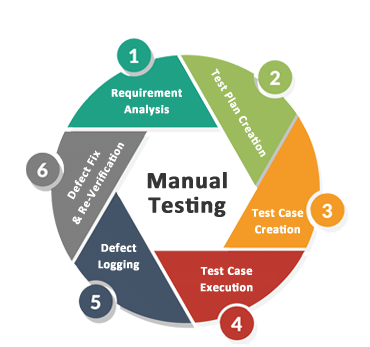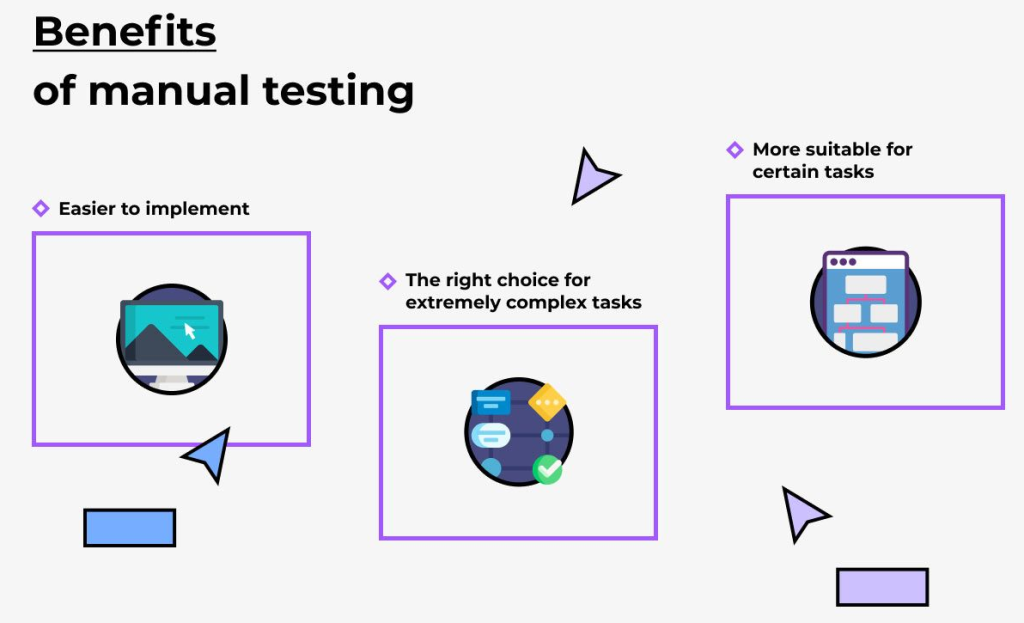
Manual testing is the method employed to scrutinize software and applications to pinpoint problems like bugs, defects, errors, and other imperfections. It is a human-driven process, as opposed to automated tools, where individuals, typically developers and testers, engage with the product or service from the user’s standpoint to assess its functionality. Testers closely resemble hackers in the sense that they subject the application to rigorous testing, attempting to uncover vulnerabilities and evaluate how it behaves when subjected to various scenarios.
What is manual testing in simple words?

Manual testing is a software testing process in which testers execute test cases manually, without relying on automated tools. Testers perform these test cases based on the end user’s perspective to determine whether the application functions according to the requirements specified in the documentation. This process aims to verify that the software behaves as expected.
Why do we need manual testing?

Given the changing trends in the software industry, many software professionals are leaning towards automated testing. However, several reasons still underscore the importance of manual testing. Some of these reasons include:
- Complex Test Scenarios: Manual testing is more adept at handling complex test scenarios that might be challenging to automate effectively.
- Usability Testing: To evaluate the user-friendliness and overall user experience of a software application, manual testing is indispensable.
- Exploratory Testing: Manual testing is the preferred method for exploratory testing, where testers delve into the application without predefined test cases to discover unexpected issues.
- Initial Phases of Development: Manual testing is valuable in the early stages of development, before automated scripts are available. It helps in identifying and addressing issues at the project’s outset.
- Adaptability: Manual testing is adaptable and flexible, making it ideal for fast-paced development environments and projects with evolving requirements.
- Human Insight and Creativity: Manual testing relies on human intelligence, intuition, and creativity, which are crucial for identifying defects and usability problems.
- User Acceptance Testing (UAT): Manual testing plays a critical role in UAT, allowing end-users and stakeholders to validate the software against specific requirements.
- Handling Legacy Systems: For older or legacy systems that lack automation compatibility, manual testing is often the only practical option.
- Interoperability Testing: Manual testing is essential for verifying how software interacts with different platforms, systems, and devices.
- Security Testing: Identifying security vulnerabilities and weaknesses in security mechanisms, such as data breaches, often requires manual testing.
These reasons highlight the continued relevance of manual testing in the software development and quality assurance process, despite the growing popularity of automated testing.
Why manual testing important in software development?
Manual testing is vital in software development due to a range of exclusive advantages that automated testing cannot fully replicate. These benefits encompass:
- Human Insight and Intuition: Manual testers can leverage their domain expertise, experience, and intuition to uncover bugs and usability issues that automated tests might overlook. For example, a manual tester can detect user interface elements that, while functioning correctly, might confuse users due to their placement or design.
- User Perspective: Manual testers examine software from the end-user’s viewpoint to ensure it is user-friendly and meets the requirements of the target audience. Automated tests often focus on individual features, while manual testers can evaluate the overall user experience.
- Adaptability: Manual testing is more flexible than automated testing, making it ideal for assessing complex or dynamic software. Manual testers can quickly adjust test cases or employ exploratory testing to accommodate software changes or evolving requirements.
- Cost-Effectiveness: For small or straightforward software projects, manual testing is often more cost-effective than automated testing. Furthermore, manual testing can identify bugs early in the development process, leading to cost savings in the long run.
Here are some specific scenarios where manual testing is particularly crucial:
- Testing User Interface (UI) Elements: Manual testing is essential for evaluating the appearance, usability, and functionality of UI elements like buttons, menus, and text fields. While automated tests can assess functionality, manual testers excel at identifying subtle usability issues.
- Testing Complex or Dynamic Software: Manual testing is well-suited for evaluating complex or dynamic software that is challenging to automate. This includes software interacting with multiple systems or containing real-time elements.
- Testing New Features or Changes: Manual testing ensures that new features or modifications in software work as expected and do not introduce new bugs.
- Exploratory Testing: Manual testers are excellent at exploratory testing, a process without pre-defined test cases. They apply creativity and experience to devise innovative ways to test the software.
In summary, manual testing is a fundamental component of any software development process. It can unearth a wide range of bugs and usability issues that automated testing may miss. Additionally, manual testing offers adaptability and cost-efficiency for specific software types and scenarios.
What are the Benefits of Manual Software Testing?

Manual software program checking out is the manner of manually checking out software via a human tester to perceive insects and troubles. it is regularly used together with automatic trying out to offer a comprehensive testing technique. There are several blessings to guide trying out, which include:
Flexibility: guide trying out permits for a extensive variety of testing scenarios and conditions to be examined. Testers can test the software program in ways that might not be possible with automated trying out, such as trying out the usability and consumer experience.
Detection of subtle bugs: manual testing can hit upon subtle bugs that automated checking out may not choose up. Human testers can regularly spot troubles that may not be obvious, such as visible inconsistencies or usability troubles.
Improved understanding of the software: manual testing can hit upon subtle bugs that automated checking out may not choose up. Human testers can regularly spot troubles that may not be obvious, such as visible inconsistencies or usability troubles.
Ability to test non-functional requirements: guide trying out can be used to check non-practical requirements which includes usability, performance, and safety.
Cost-effective: manual testing can be less costly than automatic checking out, in particular for small tasks or initiatives with a limited budget.
Better ROI: guide testing can provide a better go back on investment as the manual tester can use their know-how to test the software program in greater real-international scenarios and generate extra correct outcomes as they can suppose extra severely.
Better testing coverage: guide trying out can offer better testing insurance because the human tester can assume more creatively and discover one of a kind software paths.
Better testing documentation: guide checking out results in higher checking out documentation, as the human tester can take notes, screenshots, and different forms of documentation during the testing technique.
but, it is vital to note that manual checking out may be time-eating and resource-intensive. it’s far frequently used together with computerized trying out to offer a comprehensive checking out approach.
The significance of manual testing.
When considering the prevalence of automated testing and its speed, you might question the need for manual testing. However, manual testing remains crucial because every application is prone to issues, and thorough testing is necessary to ensure it functions correctly for the end user.
Manual testing involves testers putting themselves in the user’s shoes to evaluate the application from the user’s perspective. Additionally, manual testing is often a prerequisite for automated testing, as it helps identify and resolve issues that automated testing may overlook. Automated testing, while powerful, can’t replace the human element in the testing process.
Digital Marketing Manager at Cotocus